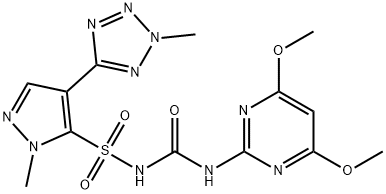Definition
ChEBI: Azimsulfuron is an N-sulfonylurea that is urea in which a nitrogen attached to one of the nitrogens has been replaced by a 4,6-dipyrimidin-2-yl group while a hydrogen attached to the other urea nitrogen has been replaced by a [1-methyl-4-(2-methyl-2H-tetrazol-5-yl)-1H-pyrazol-5-yl]sulfonyl group. An acetolactate synthase inhibitor, it is used as a herbicide for the control of a variety of broad-leaved and sedge weeds in paddy fields and other aquatic situations. It has a role as a herbicide and an EC 2.2.1.6 (acetolactate synthase) inhibitor. It is an aromatic ether, a biaryl, a N-sulfonylurea, a member of tetrazoles and a pyrazole pesticide.
Agricultural Uses
Azimsulfuron (DPX‐A8947) is a new rice herbicide introduced in 1996 by DuPont for the control of broadleaf weeds (including hard‐to‐control perennials). At application rates of 8–20 g a.i. ha−1, it provides superior weed control, including E. crus-galli, when compared with the first‐generation sulfonylurea bensulfuron at 50–75 g a.i. ha−1. Azimsulfuron is targeted to replace or supplement bensulfuron in some applications. In Japan, in planted rice, azimsulfuron is used as a premixture with bensulfuron (6 + 30 g a.i. ha−1) to boost the activity against perennial weeds. Good control has also been reported of other members of the Echinochloa family, such as E. hispidula, E. oryzicola, and E. oryzoides. Other weeds controlled include Alisma lanceolatum, A. plantago‐aquatica, Butomus umbellatus, Cyperus difformis, Scirpus maritimus, S. mucronatus, S. supinus, Heteranthera limosa, Potamogeton nodosus, Ammannia coccinea, A. robusta, Bergia capensis, and Lindernia dubia.
Azimsulfuron is sold under the trade names “Gulliver” and “Azin.”
Safety Profile
Low toxicity by ingestion,inhalation, skin contact, and intraperitoneal routes. A mildeye irritant. When heated to decomposition it emits toxicvapors of NOx and SOx.
